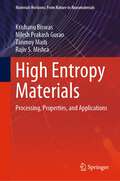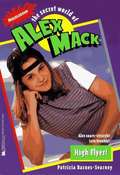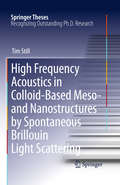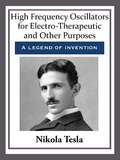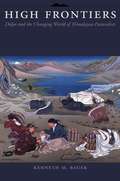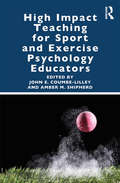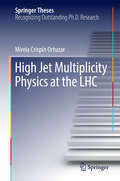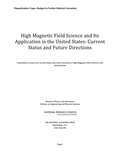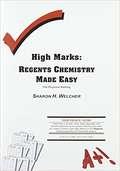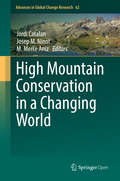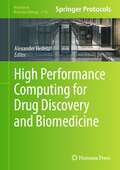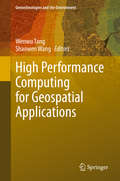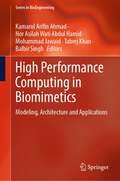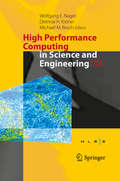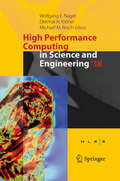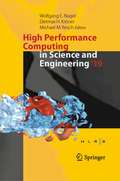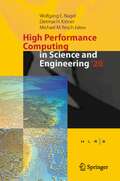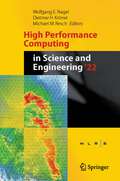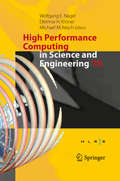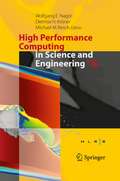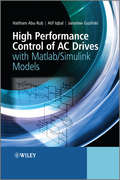- Table View
- List View
High Entropy Materials: Processing, Properties, and Applications (Materials Horizons: From Nature to Nanomaterials)
by Rajiv S. Mishra Krishanu Biswas Nilesh Prakash Gurao Tanmoy MaitiThis book provides a detailed overview of high entropy materials and alloys, discussing their structure, the processing of bulk and nanostructured alloys as well as their mechanical and functional properties and applications. It covers the exponential growth in research which has occurred over the last decade, discussing novel processing techniques, estimation of mechanical, functional and physical properties, and utility of these novel materials for various applications. Given the expanding scope of HEAs in ceramics, polymers, thin films and coating, this book will be of interest to material scientists and engineers alike.
High Flyer! (The Secret World of Alex Mack #14)
by Patricia Barnes-SvarneyUp, Up, and Away! Alex may have some unusual powers, but one thing she can't do is fly. So when her new friend Chris invites Alex and her friends to the soaring fields where his dad flies glider planes, she leaps at the opportunity. Everyone has a great time, and when Chris tells them about his dad's plan to start a flying school on the fields, they offer to help. Someone, though, is out to stop them. First, the fields are mysteriously damaged. Then one of the planes is sabotaged. Alex knows she shouldn't, but using her GC-161 powers is tempting. How else can she stop the creep who's trying to ground the sailplanes for good? ?
High Frequency Acoustics in Colloid-Based Meso- and Nanostructures by Spontaneous Brillouin Light Scattering
by Tim StillThe present thesis deals with the exploration of phononic properties of meso- and nanostructured colloid-based composite materials at hypersonic (GHz) frequencies. The emerging field of phononics, the mechanical analogue of photonics, treats the propagation and manipulation of acoustic waves in structured materials. Due to their widely tunable properties (size, density, etc.) and their ability to self-assembly, polymer colloids are ideal systems to realize hypersonic phononics, which are investigated by Brillouin light scattering herein. Therefore, both the mechanical and physical properties of the individual colloidal particles, which manifest in their resonance vibrations (eigenmodes), as well as the acoustic propagation in colloidal structures have been investigated. This thesis already lead to several journal publications and seven presentations at international conferences, and was honored summa cum laude.
High Frequency Oscillators for Electro-Therapeutic and Other Purposes
by Nikola TeslaNikola Tesla was a genius who revolutionized how the world looks at electricity.
High Frontiers: Dolpo and the Changing World of Himalayan Pastoralists
by Kenneth Michael BauerDolpo is a culturally Tibetan enclave in one of Nepal's most remote regions. The Dolpo-pa, or people of Dolpo, share language, religious and cultural practices, history, and a way of life. Agro-pastoralists who live in some of the highest villages in the world, the Dolpo-pa wrest survival from this inhospitable landscape through a creative combination of farming, animal husbandry, and trade. High Frontiers is an ethnography and ecological history of Dolpo tracing the dramatic transformations in the region's socioeconomic patterns. Once these traders passed freely between Tibet and Nepal with their caravans of yak to exchange salt and grains; they relied on winter pastures in Tibet to maintain their herds. After 1959, China assumed full control over Tibet and the border was closed, restricting livestock migrations and sharply curtailing trade. At the same time, increasing supplies of Indian salt reduced the value of Tibetan salt, undermining Dolpo's economic niche. Dolpo's agro-pastoralists were forced to reinvent their lives by changing their migration patterns, adopting new economic partnerships, and adapting to external agents of change. The region has been transformed as a result of the creation of Nepal's largest national park, the making of Himalaya, a major motion picture filmed on location, the increasing presence of nongovernmental organizations, and a booming trade in medicinal products. High Frontiers examines these transformations at the local level and speculates on the future of pastoralism in this region and across the Himalayas.
High Frontiers: Dolpo and the Changing World of Himalayan Pastoralists (Historical Ecology Series)
by Kenneth Michael BauerDolpo is a culturally Tibetan enclave in one of Nepal's most remote regions. The Dolpo-pa, or people of Dolpo, share language, religious and cultural practices, history, and a way of life. Agro-pastoralists who live in some of the highest villages in the world, the Dolpo-pa wrest survival from this inhospitable landscape through a creative combination of farming, animal husbandry, and trade. High Frontiers is an ethnography and ecological history of Dolpo tracing the dramatic transformations in the region's socioeconomic patterns. Once these traders passed freely between Tibet and Nepal with their caravans of yak to exchange salt and grains; they relied on winter pastures in Tibet to maintain their herds. After 1959, China assumed full control over Tibet and the border was closed, restricting livestock migrations and sharply curtailing trade. At the same time, increasing supplies of Indian salt reduced the value of Tibetan salt, undermining Dolpo's economic niche. Dolpo's agro-pastoralists were forced to reinvent their lives by changing their migration patterns, adopting new economic partnerships, and adapting to external agents of change. The region has been transformed as a result of the creation of Nepal's largest national park, the making of Himalaya, a major motion picture filmed on location, the increasing presence of nongovernmental organizations, and a booming trade in medicinal products. High Frontiers examines these transformations at the local level and speculates on the future of pastoralism in this region and across the Himalayas.
High Impact Teaching for Sport and Exercise Psychology Educators
by John E. Coumbe-Lilley Amber M. ShipherdHigh Impact Teaching for Sport and Exercise Psychology Educators addresses the need for a resource on effective course design, assessment, content delivery, and classroom management that is specific to educators in the field of sport and exercise psychology and to working with the millennial learner. It provides discipline-specific ideas to improve teaching in higher education. The book provides an evidence-based guide of tried and tested teaching methods for teachers of sport and exercise psychology at all levels in all formats of education. Irrespective of the level and prior teaching experience in sport and exercise psychology, this is a starting point for delivering significant learning experiences for students in this field of study. Second, it addresses the millennial learner and recommends future teaching and learning experiences in traditional, hybrid, and online formats. Finally, High Impact Teaching for Sport and Exercise Psychology Educators provides a positive approach to engaging students in an ongoing process of learning and involvement in the field of sport and exercise psychology. This book is intended for any educator in a 2- or 4-year institution of higher education who is or will be teaching courses at the undergraduate or graduate level in sport and exercise psychology as well as students and practitioners in the areas of sport and exercise psychology and physical education.
High Jet Multiplicity Physics at the LHC
by Mireia Crispín OrtuzarThis book describes research in two different areas of state-of-the-art hadron collider physics, both of which are of central importance in the field of particle physics. The first part of the book focuses on the search for supersymmetric particles called gluinos. The book subsequently presents a set of precision measurements of “multi-jet” collision events, which involve large numbers of newly created particles, and are among the dominant processes at the Large Hadron Collider (LHC). Now that a Higgs boson has been discovered at the LHC, the existence (or non-existence) of supersymmetric particles is of the utmost interest and significance, both theoretically and experimentally. In addition, multi-jet collision events are an important background process for a wide range of analyses, including searches for supersymmetry.
High Magnetic Field Science and Its Application in the United States
by National Research Council Division on Engineering and Physical Sciences Board on Physics and Astronomy Committee to Assess the Current Status and Future Direction of High Magnetic Field Science in the United StatesThe Committee to Assess the Current Status and Future Direction of High Magnetic Field Science in the United States was convened by the National Research Council in response to a request by the National Science Foundation. This report answers three questions: (1) What is the current state of high-field magnet science, engineering, and technology in the United States, and are there any conspicuous needs to be addressed? (2) What are the current science drivers and which scientific opportunities and challenges can be anticipated over the next ten years? (3) What are the principal existing and planned high magnetic field facilities outside of the United States, what roles have U.S. high field magnet development efforts played in developing those facilities, and what potentials exist for further international collaboration in this area? A magnetic field is produced by an electrical current in a metal coil. This current exerts an expansive force on the coil, and a magnetic field is "high" if it challenges the strength and current-carrying capacity of the materials that create the field. Although lower magnetic fields can be achieved using commercially available magnets, research in the highest achievable fields has been, and will continue to be, most often performed in large research centers that possess the materials and systems know-how for forefront research. Only a few high field centers exist around the world; in the United States, the principal center is the National High Magnetic Field Laboratory (NHMFL). High Magnetic Field Science and Its Application in the United States considers continued support for a centralized high-field facility such as NHFML to be the highest priority. This report contains a recommendation for the funding and siting of several new high field nuclear magnetic resonance magnets at user facilities in different regions of the United States. Continued advancement in high-magnetic field science requires substantial investments in magnets with enhanced capabilities. High Magnetic Field Science and Its Application in the United States contains recommendations for the further development of all-superconducting, hybrid, and higher field pulsed magnets that meet ambitious but achievable goals.
High Marks: Regents Chemistry Made Easy: The Physical Setting
by Sharon WelcherHigh Marks: Regents Chemistry Made Easy : the Physical Setting
High Marks: Regents Living Environment Made Easy
by Sharon H. WelcherLearn more about biology and physical science through this easy study guide.
High Mountain Conservation in a Changing World
by Jordi Catalan Josep M Ninot M. Mercè AnizThis book provides case studies and general views of the main processes involved in the ecosystem shifts occurring in the high mountains and analyses the implications for nature conservation. Case studies from the Pyrenees are preponderant, with a comprehensive set of mountain ranges surrounded by highly populated lowland areas also being considered. The introductory and closing chapters will summarise the main challenges that nature conservation may face in mountain areas under the environmental shifting conditions. Further chapters put forward approaches from environmental geography, functional ecology, biogeography, and paleoenvironmental reconstructions. Organisms from microbes to large carnivores, and ecosystems from lakes to forest will be considered. This interdisciplinary book will appeal to researchers in mountain ecosystems, students and nature professionals. This book is open access under a CC BY license.
High Performance Computing for Drug Discovery and Biomedicine (Methods in Molecular Biology #2716)
by Alexander HeifetzThis volume explores the application of high-performance computing (HPC) technologies to computational drug discovery (CDD) and biomedicine. The first section collects CDD approaches that, together with HPC, can revolutionize and automate drug discovery process, such as knowledge graphs, natural language processing (NLP), Bayesian optimization, automated virtual screening platforms, alchemical free energy workflows, fragment-molecular orbitals (FMO), HPC-adapted molecular dynamic simulation (MD-HPC), and the potential of cloud computing for drug discovery. The second section delves into computational algorithms and workflows for biomedicine, featuring an HPC framework to assess drug-induced arrhythmic risk, digital patient applications relevant to the clinic, virtual human simulations, cellular and whole-body blood flow modeling for stroke treatments, prediction of the femoral bone strength from CT data, and many more subjects. Written for the highly successful Methods in Molecular Biology series, chapters include introductions to their respective topics, lists of the necessary software and tools, step-by-step and readily reproducible modeling protocols, and tips on troubleshooting and avoiding known pitfalls. Authoritative and practical, High Performance Computing for Drug Discovery and Biomedicine allows a diverse audience, including computer scientists, computational and medicinal chemists, biologists, clinicians, pharmacologists and drug designers, to navigate the complex landscape of what is currently possible and to understand the challenges and future directions of HPC-based technologies.
High Performance Computing for Geospatial Applications (Geotechnologies and the Environment #23)
by Shaowen Wang Wenwu TangThis volume fills a research gap between the rapid development of High Performance Computing (HPC) approaches and their geospatial applications. With a focus on geospatial applications, the book discusses in detail how researchers apply HPC to tackle their geospatial problems. Based on this focus, the book identifies the opportunities and challenges revolving around geospatial applications of HPC. Readers are introduced to the fundamentals of HPC, and will learn how HPC methods are applied in various specific areas of geospatial study. The book begins by discussing theoretical aspects and methodological uses of HPC within a geospatial context, including parallel algorithms, geospatial data handling, spatial analysis and modeling, and cartography and geovisualization. Then, specific domain applications of HPC are addressed in the contexts of earth science, land use and land cover change, urban studies, transportation studies, and social science. The book will be of interest to scientists and engineers who are interested in applying cutting-edge HPC technologies in their respective fields, as well as students and faculty engaged in geography, environmental science, social science, and computer science.
High Performance Computing in Biomimetics: Modeling, Architecture and Applications (Series in BioEngineering)
by Mohammad Jawaid Tabrej Khan Kamarul Arifin Ahmad Balbir Singh Nor Asilah Wati Abdul HamidThis book gives a complete overview of current developments in the implementation of high performance computing (HPC) in various biomimetic technologies. The book presents various topics that are subdivided into the following parts: A) biomimetic models and mechanics; B) locomotion and computational methods; C) distributed computing and its evolution; D) distributed and parallel computing architecture; E) high performance computing and biomimetics; F) big data, management, and visualization; and G) future of high performance computing in biomimetics. This book presents diverse computational technologies to model and replicate biologically inspired design for the purpose of solving complex human problems. The content of this book is presented in a simple and lucid style which can also be used by professionals, non-professionals, scientists, and students who are interested in the research area of high performance computing applications in the development of biomimetics technologies.
High Performance Computing in Science and Engineering ' 17
by Wolfgang E. Nagel Michael M. Resch Dietmar H. KrönerThis book presents the state-of-the-art in supercomputer simulation. It includes the latest findings from leading researchers using systems from the High Performance Computing Center Stuttgart (HLRS) in 2017. The reports cover all fields of computational science and engineering ranging from CFD to computational physics and from chemistry to computer science with a special emphasis on industrially relevant applications. Presenting findings of one of Europe’s leading systems, this volume covers a wide variety of applications that deliver a high level of sustained performance.The book covers the main methods in high-performance computing. Its outstanding results in achieving the best performance for production codes are of particular interest for both scientists and engineers. The book comes with a wealth of color illustrations and tables of results.
High Performance Computing in Science and Engineering ' 18: Transactions of the High Performance Computing Center, Stuttgart (HLRS) 2018
by Wolfgang E. Nagel Michael M. Resch Dietmar H. KrönerThis book presents the state-of-the-art in supercomputer simulation. It includes the latest findings from leading researchers using systems from the High Performance Computing Center Stuttgart (HLRS) in 2018. The reports cover all fields of computational science and engineering ranging from CFD to computational physics and from chemistry to computer science with a special emphasis on industrially relevant applications. Presenting findings of one of Europe’s leading systems, this volume covers a wide variety of applications that deliver a high level of sustained performance.The book covers the main methods in high-performance computing. Its outstanding results in achieving the best performance for production codes are of particular interest for both scientists and engineers. The book comes with a wealth of color illustrations and tables of results.
High Performance Computing in Science and Engineering '19: Transactions of the High Performance Computing Center, Stuttgart (HLRS) 2019
by Wolfgang E. Nagel Michael M. Resch Dietmar H. KrönerThis book presents the state-of-the-art in supercomputer simulation. It includes the latest findings from leading researchers using systems from the High Performance Computing Center Stuttgart (HLRS) in 2019. The reports cover all fields of computational science and engineering ranging from CFD to computational physics and from chemistry to computer science with a special emphasis on industrially relevant applications. Presenting findings of one of Europe’s leading systems, this volume covers a wide variety of applications that deliver a high level of sustained performance.The book covers the main methods in high-performance computing. Its outstanding results in achieving the best performance for production codes are of particular interest for both scientists and engineers. The book comes with a wealth of color illustrations and tables of results.
High Performance Computing in Science and Engineering '20: Transactions of the High Performance Computing Center, Stuttgart (HLRS) 2020
by Wolfgang E. Nagel Michael M. Resch Dietmar H. KrönerThis book presents the state-of-the-art in supercomputer simulation. It includes the latest findings from leading researchers using systems from the High Performance Computing Center Stuttgart (HLRS) in 2020. The reports cover all fields of computational science and engineering ranging from CFD to computational physics and from chemistry to computer science with a special emphasis on industrially relevant applications. Presenting findings of one of Europe’s leading systems, this volume covers a wide variety of applications that deliver a high level of sustained performance.The book covers the main methods in high-performance computing. Its outstanding results in achieving the best performance for production codes are of particular interest for both scientists and engineers. The book comes with a wealth of color illustrations and tables of results.
High Performance Computing in Science and Engineering '22: Transactions of the High Performance Computing Center, Stuttgart (HLRS) 2022
by Wolfgang E. Nagel Michael M. Resch Dietmar H. KrönerThis book presents the state-of-the-art in supercomputer simulation. It includes the latest findings from leading researchers using systems from the High Performance Computing Center Stuttgart (HLRS) in 2022. The reports cover all fields of computational science and engineering ranging from CFD to computational physics and from chemistry to computer science with a special emphasis on industrially relevant applications. Presenting findings of one of Europe’s leading systems, this volume covers a wide variety of applications that deliver a high level of sustained performance.The book covers the main methods in high-performance computing. Its outstanding results in achieving the best performance for production codes are of particular interest for both scientists and engineers. The book comes with a wealth of color illustrations and tables of results.
High Performance Computing in Science and Engineering ´15: Transactions of the High Performance Computing Center, Stuttgart (HLRS) 2015
by Wolfgang E. Nagel Michael M. Resch Dietmar H. KrönerThis book presents the state-of-the-art in supercomputer simulation. It includes the latest findings from leading researchers using systems from the High Performance Computing Center Stuttgart (HLRS) in 2015. The reports cover all fields of computational science and engineering ranging from CFD to computational physics and from chemistry to computer science with a special emphasis on industrially relevant applications. Presenting findings of one of Europe’s leading systems, this volume covers a wide variety of applications that deliver a high level of sustained performance. The book covers the main methods in high-performance computing. Its outstanding results in achieving the best performance for production codes are of particular interest for both scientists and engineers. The book comes with a wealth of color illustrations and tables of results.
High Performance Computing in Science and Engineering ´16
by Wolfgang E. Nagel Michael M. Resch Dietmar H. KrönerThis book presents the state-of-the-art in supercomputer simulation. It includes the latest findings from leading researchers using systems from the High Performance Computing Center Stuttgart (HLRS) in 2016. The reports cover all fields of computational science and engineering ranging from CFD to computational physics and from chemistry to computer science with a special emphasis on industrially relevant applications. Presenting findings of one of Europe's leading systems, this volume covers a wide variety of applications that deliver a high level of sustained performance. The book covers the main methods in high-performance computing. Its outstanding results in achieving the best performance for production codes are of particular interest for both scientists and engineers. The book comes with a wealth of color illustrations and tables of results.
High Performance Computing in Science and Engineering ´16: Transactions of the High Performance Computing Center, Stuttgart (HLRS) 2016
by Wolfgang E. Nagel Michael M. Resch Dietmar H. KrönerThis book presents the state-of-the-art in supercomputer simulation. It includes the latest findings from leading researchers using systems from the High Performance Computing Center Stuttgart (HLRS) in 2016. The reports cover all fields of computational science and engineering ranging from CFD to computational physics and from chemistry to computer science with a special emphasis on industrially relevant applications. Presenting findings of one of Europe’s leading systems, this volume covers a wide variety of applications that deliver a high level of sustained performance.The book covers the main methods in high-performance computing. Its outstanding results in achieving the best performance for production codes are of particular interest for both scientists and engineers. The book comes with a wealth of color illustrations and tables of results.
High Performance Computing in Science and Engineering ‘12
by Wolfgang E. Nagel Michael M. Resch Dietmar H. KrönerThis book presents the state-of-the-art in simulation on supercomputers. Leading researchers present results achieved on systems of the High Performance Computing Center Stuttgart (HLRS) for the year 2012. The reports cover all fields of computational science and engineering ranging from CFD via computational physics and chemistry to computer science with a special emphasis on industrially relevant applications. Presenting results for both vector-systems and micro-processor based systems the book allows to compare performance levels and usability of various architectures. As HLRS operates not only a large cluster system but also one of the largest NEC vector systems in the world this book gives an excellent insight also into the potential of vector systems. The book covers the main methods in high performance computing. Its outstanding results in achieving highest performance for production codes are of particular interest for both the scientist and the engineer. The book comes with a wealth of coloured illustrations and tables of results.
High Performance Control of AC Drives with Matlab / Simulink Models
by Haitham Abu-Rub Jaroslaw Guzinski Atif IqbalA comprehensive guide to understanding AC machines with exhaustive simulation models to practice design and controlNearly seventy percent of the electricity generated worldwide is used by electrical motors. Worldwide, huge research efforts are being made to develop commercially viable three- and multi-phase motor drive systems that are economically and technically feasible.Focusing on the most popular AC machines used in industry - induction machine and permanent magnet synchronous machine - this book illustrates advanced control techniques and topologies in practice and recently deployed. Examples are drawn from important techniques including Vector Control, Direct Torque Control, Nonlinear Control, Predictive Control, multi-phase drives and multilevel inverters.Key features include:systematic coverage of the advanced concepts of AC motor drives with and without output filter;discussion on the modelling, analysis and control of three- and multi-phase AC machine drives, including the recently developed multi-phase-phase drive system and double fed induction machine;description of model predictive control applied to power converters and AC drives, illustrated together with their simulation models;end-of-chapter questions, with answers and PowerPoint slides available on the companion website www.wiley.com/go/aburub_controlThis book integrates a diverse range of topics into one useful volume, including most the latest developments. It provides an effective guideline for students and professionals on many vital electric drives aspects. It is an advanced textbook for final year undergraduate and graduate students, and researchers in power electronics, electric drives and motor control. It is also a handy tool for specialists and practicing engineers wanting to develop and verify their own algorithms and techniques.
